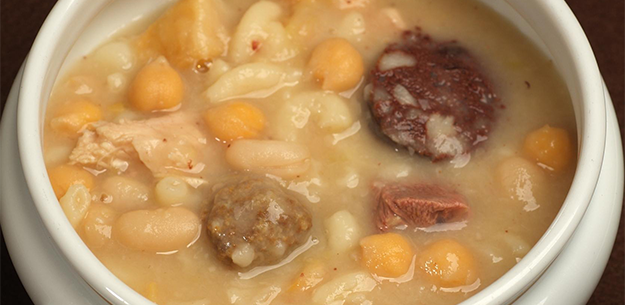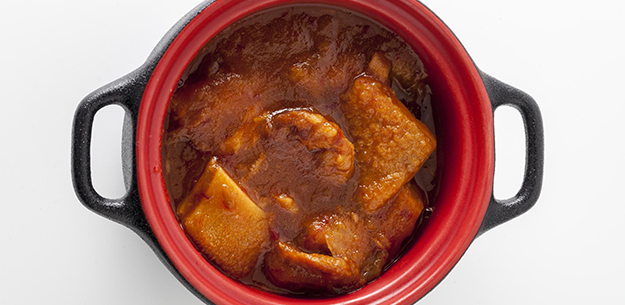.png.transform/rendition-xs/image_image%20(1).png)
The Stewpot
After primitive man discovered how to roast meat over a fire came the far more sophisticated method of boiling and stewing in a pot. Here was, indeed, the beginning of civilization, as some clever hominoid shaped a pot out of clay, filled it with chunks of mammoth, water and who knows what herbal seasoning and set it over a fire. Bubbling for hours over the embers, the meat became falling-off-the-bones tender and the broth a delicious and sustaining part of the meal.
Down through the millenia, food cooked with water in a big pot has remained one of the enduring methods of cooking.
In Spain, the olla is the great stewpot, source of one-pot meals that vary from one region of the country to another. Originally made of clay, the olla, typically, is a tall, pot-bellied vessel that sets in a tripod on the hearth fire. It's shape provided an efficient use of fuel. Cooking a whole meal in a single pot also was an economical use of firewood.
Modern-day ollas of stainless steel or enameled metal are meant for gas or electric cooktops. Over time, they have changed their pot-bellies for straight sides. Fuel efficiency is still an issue, and the olla exprés, pressure cooker, is much appreciated for shortening cooking time.
The word olla also means the boiled dinner that is cooked in the pot. Mother of all of them is the olla podrida, That's the dish that Don Quixote's sidekick, Sancho Panza, requested in Cervantes'novel. Podrida means "rotten" but in those days, perhaps, by podrida he actually meant poderida, powerful, meaning a stew pot filled with rich meat, an aristocrat's stew pot, not a rotten one. The olla podrida contained all manner of game and meat, while the poor folks' version contained rancid ham bone, salt pork, chickpeas and turnips. Very slowly cooked until the meat was falling off the bones.
Ingredients galore
Today's stews, called cocido, pote, puchero, bull or escudella, depending on the region of the country, is one of the glories of traditional Spanish cuisine. It consists of chickpeas simmered slowly in a covered pot with stewing hen, ham hock, beef, traditional sausages like morcilla (black sausage) or chorizo, aromatic vegetables, potatoes and sometimes cabbage. Legumes such as chickpeas, haricot beans or lentils must be soaked overnight before putting them to cook in the olla. Cooking time varies, depending on the ingredients, but for a cocido with chickpeas can be two hours or more.
To serve, the broth is separated and cooked with thin noodles or rice and served as a first course. A platter of meat, chicken and traditional sausages follows with another platter for the chickpeas and vegetables from the pot. Elaborate versions for fiesta days incorporate a relleno, a big meatball, and may require more than a single olla to cook the many ingredients.
Potajes, or potages, are also one-pot stews, usually containing legumes such as beans or lentils plus sausage and vegetables. Unlike cocidos, they are served in one bowl, soup, vegetables and meats all together.
Janet Mendel is a food writer based in southern Spain. She is the author of several books about Spanish food, including Cooking in Spain and Tapas: a bite of Spain (Santana Books, Spain); My Kitchen in Spain and Cooking from the Heart of Spain-Food of La Mancha (Harper Collins), and Traditional Spanish Cooking (Frances Lincoln, UK).


- The Stewpot 1
- The Stewpot 2
